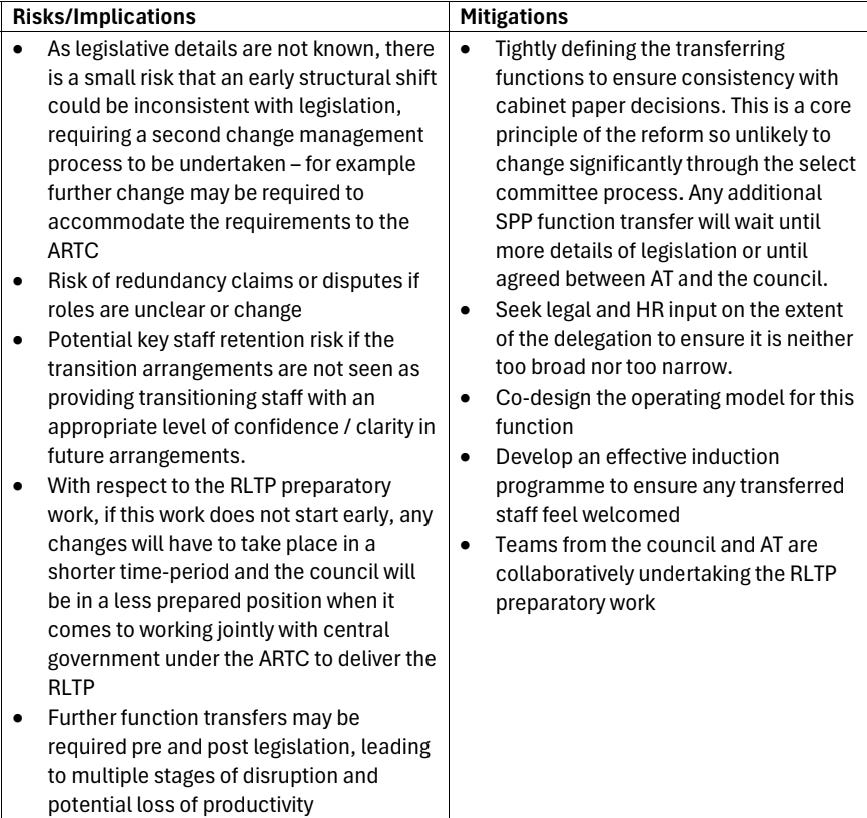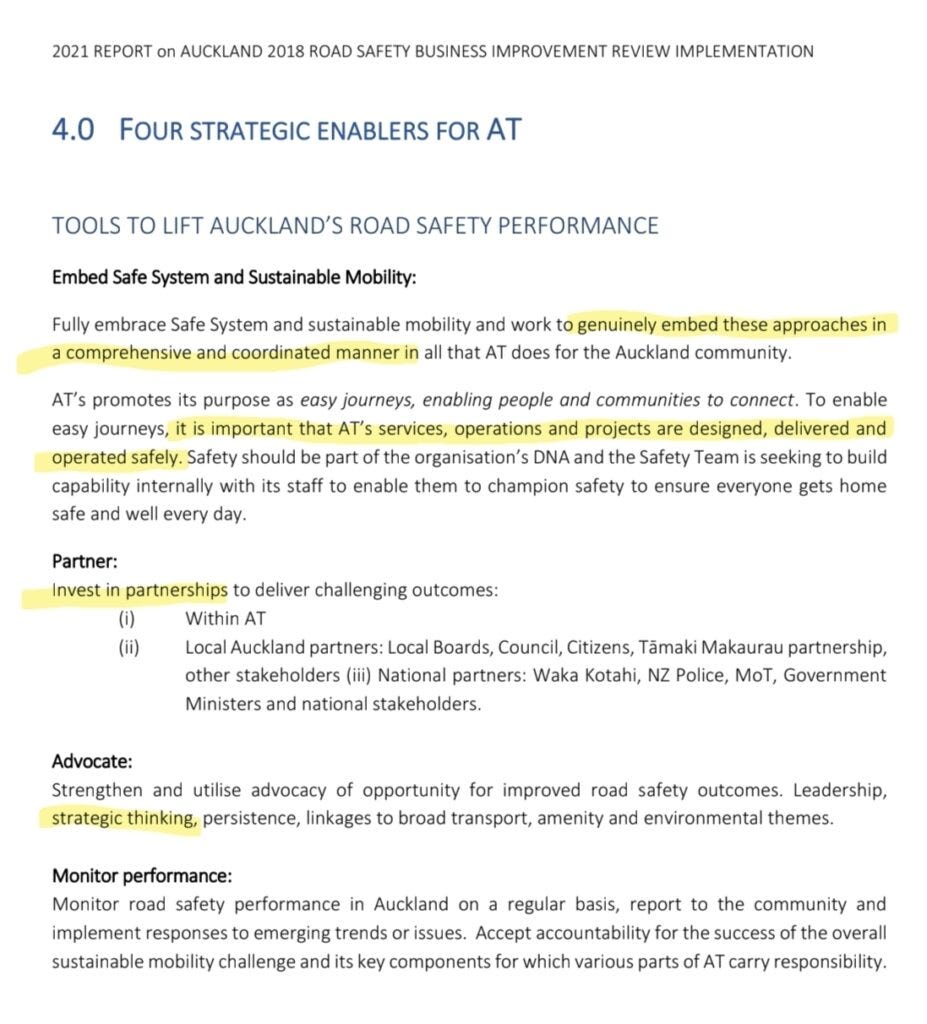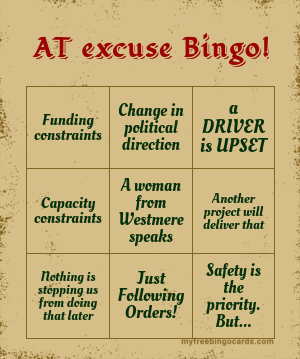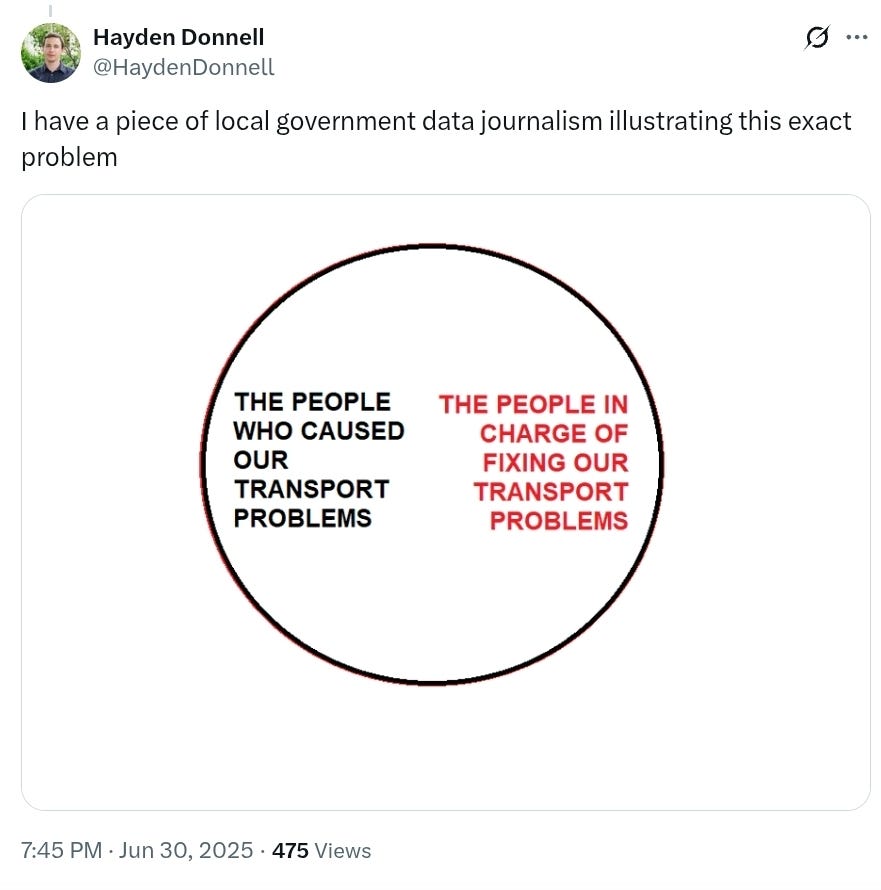This guest post by Tim Adriaansen, a Strategic Transport Advisor and advocate for accessibility and sustainable transport
Auckland Transport is about to experience its next big shakeup, with items recently presented to the AT board and the Governing Body of Auckland Council covering how strategy and policy functions will start to move back to Council prior to any legislative changes.
These changes are desperately needed, as over the last 10 years Auckland Transport has demonstrated an inability to align their long-term performance with the expectations of Aucklanders and elected representatives (Councillors and Local Board members). Not only has this resulted in a persistently poor reputation for AT, but that reputation has been well-earned by failing to deliver where improved transport options, safety or climate are concerned.
The best outcome from this upcoming change process would be for Auckland Council to build a strong, competent team of systems-thinkers who collectively possess the various skill sets needed to create a great transport system: Transport planning, yes; but also urban planning and economics, long-term financial management (and understanding how investments today shape expenditure tomorrow), political and social science and communication, environment and health, te ao Māori, and wellbeing, equity, and universal accessibility.
Above all, the team will need a reputable manager who demonstrates relentless positive leadership, and can keep staff motivated as they persevere through predictable challenges to deliver results. Getting things done in transport is never easy, so this needs to be a team that works well together, will work well across organisations, and shares Aucklander's vision for their city.
Auckland Transport and Auckland Council already have a number of excellent staff who fit the bill, and their local and institutional knowledge is unmatched. They're the obvious first port of call when seeking members for Auckland's regional transport super-group.
There's a big risk involved, however: The upcoming changes might cut-and-paste problematic parts of Auckland Transport into Auckland Council. Not only would this miss an opportunity to improve things, it could exacerbate existing problems with poor decision making, policy direction and an unhealthy workplace culture—all things which Auckland Council (and Auckland as a region) cannot afford to adopt.
Getting the right people will make-or-break the region's transport reforms, and should be the issue given the most focus by those, like Mayor Wayne Brown, who want to achieve good long-term outcomes.
It's also tricky: Getting “the wrong people into the wrong positions” isn't highlighted as a risk in the advice given to decision makers. It's one of those subjects that culturally, New Zealanders don't like to confront, and something that professionally, employees may be hesitant to raise or express.
The worst possible outcome of this process would be to get the wrong people into the wrong positions. If that happens, those people would likely become embedded in the new structure, and the whole ordeal would be futile. To get good results, one key problem at Auckland Transport needs to be resolved.

Understanding the problem
The first thing to understand is this: Auckland's many transport challenges, including safety, pollution and traffic congestion, are solvable. Political interference, public reputation and financial constraints are solvable issues, too. In fact, experienced transport professionals already know how to fix these problems, and we know that most of the time, it's cheaper and easier to implement the solution than it is to maintain the status quo (particularly if we take a long-term view—which is what smart cities do). Where Auckland Transport has been chronically failing is in implementing those solutions.
One of the interesting cultural ideas that persists within Auckland Transport is the opposite of this: That the organisation is besieged by so many problems, all of which need time and support and resources to manage and which, collectively, make it all but impossible to get things done—particularly big things, like the Transport Emissions Reduction Pathway. Staff are frequently preoccupied with an endless list of constraints on their ability to deliver, and quite rationally resort to tackling “what's within our control”. This gets reported upwards and results in managers feeling like a Herculean effort is required to really change anything in a substantial manner (short of a Deus-ex-Machina approach where a central-government driven mega-project arrives, with associated central-government mega-funding). Internally, the solutions to Auckland's transport problems—solutions that are being rolled out in cities right across the world—look to be unattainable. To fix Auckland Transport, we need to understand why this is.
Alongside the siloisation of the organisation, where things like safety and active transport are funded and managed separately to things like engineering and road operations, the barrage of “problems"—which includes everything from shifts in government funding and policy, to extreme weather events, to unhelpful text messages between high-ranking politicians and senior staff—create conditions which strongly favour business as usual.
Business as usual is a safe and steady approach which produces reliable results. But there's a big problem: Those results are reliably the wrong results. They don't track towards the long-term outcomes that the people of Auckland need their transport agency to achieve, or what elected representatives expect big budgets of ratepayer money to deliver.
Those outcomes are outlined in the Auckland Plan 2050, described by Auckland Council as “our long-term spatial plan to ensure Auckland grows in a way that will meet the opportunities and challenges of the future.”
This well-considered and widely-consulted plan is the best resource for understanding the long-term vision for the region, as it doesn't suffer from the back-and-forth of 3-year election cycles, or from the recency and awareness biases of yearly key-performance-indicators and Mayoral letters of expectation. Good strategy is about achieving the big-picture, long-term stuff, while tactics respond to the year-to-year zeitgeist of politics and media.
The Auckland Plan was developed in 2018 and includes 3 key directions and 7 focus areas which Auckland Transport should be delivering on, and against which long-term success can be evaluated. These are:
Direction 1: Maximise safety, environmental protection and emissions reduction
Direction 2: Better connect people, places, goods and services
Direction 3: Increase genuine travel choices for a healthy, vibrant and equitable Auckland
And the focus areas:
Make better use of existing transport networks
Target new transport investment to the most significant challenges
Maximise the benefits of new transport technology
Make walking, cycling and public transport the preferred choices for many more Aucklanders
Better integrate land-use and transport
Move to a safe transport system free from death and serious injury
Develop a sustainable and resilient transport system
Without spending too much time on them, it's fairly easy to identify that Auckland Transport hasn't been delivering strongly to these outcomes, and in some cases measures up very poorly.
Take the first direction, for instance: Maximise safety, environmental protection and emissions reduction—literally the number one thing AT should be working towards.
Almost every year since adopting their Vision Zero policy, AT have watered down the target for reducing deaths and serious injuries (as reported in the key performance indicators contained within their annual statements of intent).
Auckland Transport have consistently failed to deliver critical aspects of the Vision Zero programme—such as effective advocacy and education, or physical engineering to promote mode-shift to active travel—and as a result, have managed to lose public and political support for road safety, leading to the abandonment of their award-winning safe speeds programme and the effective (and hopefully temporary) demise of Vision Zero. It's worth highlighting that this isn't an issue with the road safety team—who operate to the best of their ability from inside an organisational silo with limited resourcing—but of the organisation at a broader scale for failing to effectively adopt supporting actions outside of the road safety team and across the wider organisation—principally communication and engineering strategies.

AT have also all but shunned their climate responsibilities, with a “don't ask, don't tell” attitude to talking about transport system pollution and delivery on Auckland's climate plan. In fact, Auckland Transport doesn't currently have anybody whose job it is to monitor or reduce transport system emissions, nor have they assembled a leadership team to implement the emissions reduction pathway, nor do they have a public-facing communications campaign to build support for necessary changes, nor do they report back to Council on emissions reduction progress (some level of accounting is sure to come under AT's Climate Transition Plan, but this is likely to focus on corporate emissions and not the whole-of-system measures AT are responsible for).
It's worth mentioning that climate breakdown isn't a political problem that can be assuaged with talking points or deferred until it's no longer a priority. Carbon pollution is a physics problem, and the longer Auckland Transport takes to deal with it responsibly, the more difficult and expensive that dealing becomes. AT's current approach to “maximising emissions reduction” seems to be a combination of deflection, denial and delay. One thing they're definitely not doing is delivering.

For many staff at Auckland Transport, these big-ticket outcomes seem so far removed from their day-to-day jobs that it's fairly easy to dismiss them as an unnecessary distraction from the task at hand. And that's a fair thing to do: If everybody had to consider every long-term consequence of every interaction across the transport system, they'd spend all day conceptualising, modelling, data-analysing, consulting and theorising; and probably get a lot less done (those in the industry know that enough of all that stuff happens already!)
That's why a credible strategy for achieving long-term outcomes is critical for an organisation as big as Auckland Transport, an organisation tasked with managing a complex regional transport system for what will soon be 2 million people. That strategy needs to be translated into policy, and that policy needs to guide planning, funding and investment decisions, so that resources are effectively allocated in a way that will resolve the many interrelated problems that complex systems inherently have.
Auckland's transport problems are solvable. Experienced transport professionals know what the solutions are and we know that implementing them will lead to better results across the board.
We know that it's possible to reduce emissions and improve safety, and that doing so will reduce transport expenditure and help solve traffic congestion and accessibility problems. We know that getting this stuff done requires ongoing socialisation and community engagement, to maintain public support. We know that Auckland Transport's reputation can be improved by delivering these solutions, because they align with what Aucklanders value for their city. And we know that political interference can change into political support, making funding much easier to access—but only if Auckland Transport works towards a positive vision that Aucklanders and their representatives can get behind.
The first problem to tackle (the real problem—the one which any restructure or institutional reshuffle needs to solve) is that, for whatever reason, Auckland Transport has never developed nor delivered on a strategy to make all this happen.
The role of Strategy
In a well-managed organisation, people shouldn't feel like they're fighting an endless flood of constraints. With good strategy and appropriate resource allocation, alongside strong leadership and a clear vision, it becomes obvious how staff can contribute towards the bigger goal. Staff are empowered by boundaries which narrow their focus towards effectiveness, rather than feeling frustrated or disenfranchised by problems over which they have little or no control.
On the flipside, it's fairly easy to tell when an organisation lacks cohesive strategy: When senior staff are questioned about long-term objectives, the responses will highlight problems, constraints, and short-term issues, rather than detailing which part of the organisation has been given the task of solving the problem, and how they're going to go about doing so. An organisation which lacks strategy will speak in excuses instead of actions.
When Auckland Transport’s senior officers are questioned by Auckland Council on the big-ticket items like safety and emissions—month after month, year after year—those AT officers tend to respond with excuses. The excuses are so regular and reliable that it's possible to play “AT excuse bingo” at any committee meeting or workshop where Auckland Transport senior managers front up to answer questions.
The most common problems AT use as a non-delivery crutch are:
Funding constraints
Shifting policy direction
Opposition to a project, usually from some fringe group or figure
Organisational capacity or capability limitations
Project sequencing or integration issues
Until recently, COVID-19 or the Auckland Anniversary floods

But here's the thing: The role of strategy and policy is to mitigate and minimise these potential issues and help senior staff navigate a pathway through them, which in turn helps managers delegate empowering actions across the organisation. Auckland Transport shouldn't be seeing the same issues coming up time and time again, because the problems are predictable—and it's their job to solve them. Auckland Transport exists to get us moving ahead, not to keep us running on a predictable-problem treadmill.
The consistent pattern of excuse-making around long-term objectives makes it clear: Something's going very wrong with AT's internal strategy department.
Because many of the people who develop and advise on strategy are also involved in policy and planning, and because the organisation is structured so that strategic decisions cascade outwards, poor strategy becomes bad policy and bad investment.
By the time policy is written and funding is allocated, other teams across the organisation find only constraints and challenges, rather than pathways designed to help them achieve success. The end results speak for themselves.

An opportunity for change
Thankfully, the items presented to the AT board and Auckland Council's governing body get to the heart of the issue, and the process calls for strategy and policy functions to move back to Auckland Council (it's unclear why this wasn't always the case). Worryingly, the item also mentions a transfer of AT staff to go along with these duties.
As previously noted, there are some brilliant people at Auckland Transport. But there are also some problematic parts of the organisation, and sometimes getting better results requires, quite bluntly, getting better people.
The transfer of strategy and policy to Auckland Council presents a once-in-a-decade opportunity to solve some critical systemic problems that have been holding the region back and making Auckland Transport, as a whole, much less effective.
Instead of taking the part of Auckland Transport that clearly isn't working and installing it into Auckland Council (which simply moves the problem around, but doesn't solve it), a much better option will be for those involved in the change process to focus on building a new, highly-capable team. Recruiting widely (including internationally) and selecting for the right mix of skills should produce a team that can confidently navigate Auckland's transport problems—getting transport delivery off of the predictable-problem treadmill, and steering the Auckland region towards consistently great transport outcomes.
This post, like all our work, is brought to you by the Greater Auckland crew and made possible by generous donations from our readers and fans. If you’d like to support our work, you can join our circle of supporters here, or support us on Substack!





